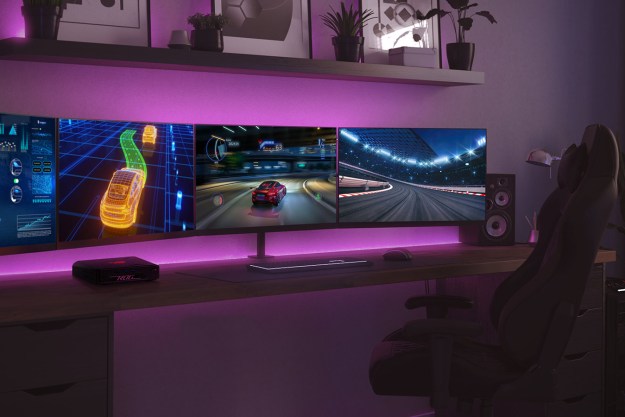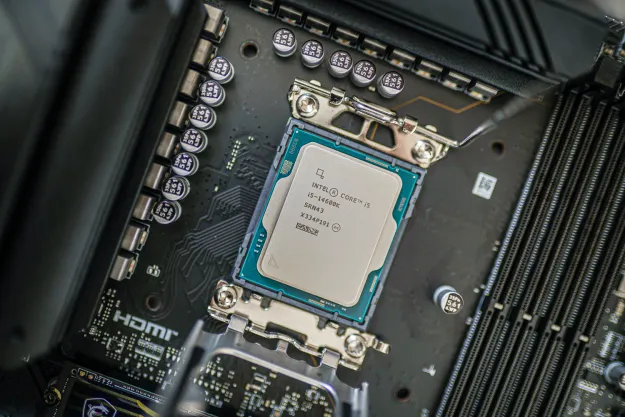NUC! I choose you!
Before you buy any components, you’ll need to decide on the NUC itself. There’s several current models available, and they can be divided into three main categories. On the low end there’s the Celeron and Pentium powered models that sell for $130 to $180. Though affordable, their performance is limited, so they’re only suited for the most basic PCs.
The next step up are the Core i3 and i5 models. These have more capable processors, better integrated graphics, and bump the maximum RAM from eight to sixteen gigabytes. They also feature a few more ports. The i3 models retail for around $280, while i5 models start around $370. Aside from the processor, integrated graphics is the only major difference between the two; the i3 has Intel HD 5500, while the i5 has HD 6000. Both models have the same enclosure and connectivity options.
Then there’s the king of all NUCs, the i7, which ships at about $475. It unfortunately doesn’t have a quad-core i7, but it does offer the highest clock speed of any NUC, and bumps the integrated graphics up to Intel’s Iris 6100. This model is also available only in the larger NUC case. We recommend most users steer clear, as the marginal bump in performance isn’t worth the significant step up in price.
While most NUCs have an enclosure, there is a line available without. These are officially called “Board” systems rather than “Kit” systems. These are difficult to find, and don’t have a price advantage compared to those with a case, so we don’t recommend them.
The mid-range “fat” Core i5 model, known as the NUC5i5RYH, is likely the best overall value. It offers an Intel Core i5-5250U processor with HD 6000 graphics for $359, and it can support either M.2 or SATA hard drives.
A question of memory
As mentioned, most NUCs support up to sixteen gigabytes of RAM, with the exception of the entry-level Celeron and Pentium units. We recommend installing at least 4GB of memory if you purchase a Pentium or Celeron model, and at least 8GB if you go with a Core variant. You may not actually need that much, but DDR3 memory is at its lowest price in years.
NUCs have only two DIMM slots available, and they’ll only accept smaller laptop memory rather than full-sized desktop memory.
Your best bet is to buy a matching pair that, in sum, offers the RAM desired. If you’d like 8GB of memory, then, you’ll want to buy a pair of two 4GB sticks. That’ll set you back about $50 at current prices. It’s important to buy a matching pair of memory. Your NUC may not boot if you try to mix-and-match different types and sizes of
We recommend sticking with basic 1333MHz, DDR3 memory, because NUCs won’t be used for tasks demanding enough to benefit from faster RAM. This set from G.Skill is a reliable, inexpensive choice.
Mass storage
Once you have the RAM sorted, you’ll want to turn to the hard drive. Depending on the NUC you buy, you’ll either have the ability to install a 2.5” SATA hard drive and M.2 solid state drive, or just the latter.
The M.2 SSD is the way to go if performance is your priority. These tiny drives, which look a bit like a stick of RAM, are smaller, easier to install and offer excellent performance, and they’re only slightly more expensive than a similar 2.5” drive on average. We recommend the Samsung 850 Evo. You can grab a 250GB version of $120.
If mass storage is your goal, you can select a larger, less expensive 2.5″ solid state drive. Western Digital’s WD5000LPLX is a good choice among the mechanical options, as it offers 500GB for just $55. Those looking for solid state can go with the SATA version of the Samsung 850 Evo, which offers 500GB for about $180.
Note that the NUCs supporting SATA drives have a height limit of nine millimeters. The highest capacity drives that we know will fit are the Western Digital Blue series and the Western Digital Hybrid Drive series. These can be had in capacities up to 1TB.
What you don’t need
You may wondering if there’s any additional peripherals needed, like Wi-Fi, Ethernet, or Bluetooth. Generally speaking, the answer is no. Even the least expensive NUC has 802.11ac with Bluetooth 4.0, several USB 3.0 ports, and an Ethernet jack. All of the most recent models can support a 4K monitor over mini-DisplayPort, as well.
Rejoice! Windows is free
That’s all the hardware, but you still need an operating system. Fortunately, Microsoft has given you a new option – the Windows 10 Insider program. Enrollment is free, and provides you perpetual free use of the operating system. The catch is you must continually upgrade your system, as each build will eventually expire. Linux is an option, too.
You can buy a retail copy of Windows, of course. Note that whatever you buy, you’ll have to obtain a .ISO file and install via a USB stick, or use an optical hard drive for installation, since there’s no optical drive available in the NUC itself. No version of Windows is particularly well suited to the NUC; as long as you grab Windows 7 or newer, you’ll be fine.
That’s all you need to know to buy a NUC and properly outfit it. My personal recommendation, if you want maximum bang for your buck, is to buy the NUC5i5RYK, eight gigabytes of DDR3 1333MHz RAM, and a 250GB Samsung 850 Evo M.2 hard drive. This configuration will work out to about $530 if you use the free Windows Insider Program, making the NUC a very affordable, yet surprisingly capable, small PC.
Editors' Recommendations
- Intel finally responds to CPU instability but only makes it more confusing
- 9 best processors for PC gaming: tested and reviewed
- Gamers are reportedly returning Intel Core i9 CPUs in droves
- Intel’s next-gen GPU might be right around the corner
- How Intel and Microsoft are teaming up to take on Apple




